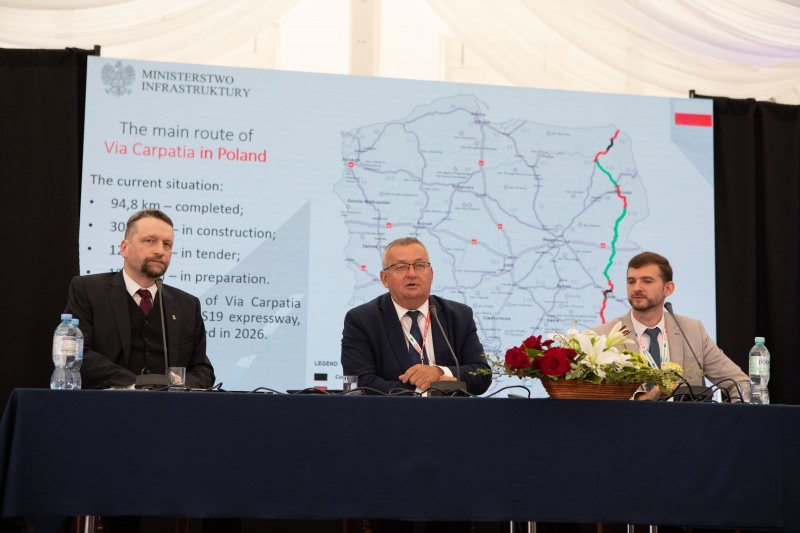The total length of the Via Carpatia route on the Polish territory is approximately 700 km. Almost 100 km are already completed, with another 301.3 km under construction, 124.3 km in the process of tender, and 194.2 km in preparation. These are the current numbers for the Polish section of the international Via Carpatia route, i.e. the transport backbone for the Three Seas countries. According to the Infrastructure Minister Andrzej Adamczyk, who took part in one of the panels of the Summer University held at Krasiczyn Castle, more sections between Rzeszów and Lublin will be commissioned for use in 2021, and the entire route on the Polish territory will be put into service by 2026 as an expressway.

Minister of Infrastructure Andrzej Adamczyk (centre). Photo by www.mymedia.pl
The initiative behind building the Via Carpatia international route, linking Klaipėda in Lithuania with Thessaloniki in Greece, dates back to 2006 and President Lech Kaczyński. In 2006, in Łańcut, the ministers for transport of Poland, Hungary, Lithuania and Slovakia signed a declaration which formally launched plans for the construction of the Via Carpatia road. – Via Carpatia completes the road network in Europe. A network that allows movement between north and south. To date, the main focus has been on the implementation of east-west transport projects. The element of the communication grid which we are building allows, and will allow, to communicate smoothly between the north and the south – noted the Minister.
Economic and geopolitical importance
– The countries lying between the Baltic, the Adriatic and the Black Sea have enormous, as yet untapped economic potential. Currently, as many as 11 countries are members of the Via Carpatia initiative. Thanks to our joint involvement, we have a chance to build a safe, modern and comfortable road, which will connect the Baltic Sea ports, via Lublin, Rzeszów and Koszyce, with the Aegean Sea. The total planned length of the Via Carpatia corridor together with its branch is approximately 8800 km – explained the Minister of Infrastructure Andrzej Adamczyk during a morning debate at Krasiczyn.
These 8800 km run through seven European countries – Lithuania, Poland, Slovakia, Hungary, Romania, Bulgaria and Greece – which have a total of 125 million inhabitants. The total length of the Via Carpatia route on the Polish territory is approximately 700 km. The international corridor will eventually run through the territory of five provinces – Podlaskie, Warmińsko-Mazurskie, Mazowieckie, Lubelskie and Podkarpackie. The route will include sections of expressways S61, S16, S19 from Budzisko (state border), through Suwałki, Ełk, Białystok, Lublin, Rzeszów to Barwinek (state border).
Almost 100 km of the Via Carpatia route is already completed within Poland, with another 301.3 km under construction. Tenders have been announced for the construction of 124.3 km (at the beginning of August, the General Directorate for National Roads and Motorways announced tenders for the design and construction of two sections of the S19 expressway, which is part of the Via Carpatia international transport route, with a total length of about 24 km), and 194.2 km is still at the preparation stage. These are the current numbers for the Polish section of the international Via Carpatia route, i.e. the transport backbone for the Three Seas countries. According to the Infrastructure Minister Andrzej Adamczyk, who took part in one of the panels of the Summer University held at Krasiczyn Castle, more sections between Rzeszów and Lublin will be commissioned for use in 2021, and the entire route on the Polish territory will be put into service by 2026 as an expressway.
Comfortable travel from Warsaw to the south of Europe
On the Hungarian territory, the Via Carpatia route is almost 230 km long and runs from the Slovak border to the border with Romania (Tornyosnémeti - Miskolc - Debrecen - Romanian border). All its sections are now complete and are expected to be commissioned within the next few weeks. In Greece, too, the route is practically finished. In Slovakia, the Via Carpatia route will have a total length of 127 km and there are "some problems" with its construction, while the largest section of the north-south corridor will run through Romania for as many as 1566 km (construction is in progress).
– We assume that Via Carpatia will be passable by 2030. This is a dream come true for us, not only for the residents of the eastern provinces of Poland but also for those who would like to travel to the south of Europe from Kraków, Łódź, Warsaw or Gdańsk. We will be able to travel along the new, safe and comfortable road not only for reasons related to tourism but also in connection with economic purposes – emphasized the Minister of Infrastructure.
According to Minister Andrzej Adamczyk, once the north-south corridor is commissioned for use, Western countries will be able to plan and execute journeys from the north to the south of Europe in a predictable manner, which should benefit mainly, but not only, freight transport. – A fully integrated and efficiently functioning transport system is a guarantee of the social, economic and territorial integrity of all the regions of our continent. Central, Eastern and Southern Europe needs further infrastructural development in order to increase the economic potential of the entire community and enable a real implementation of the principles of the free movement of people, goods and services, without transport or administrative obstacles – highlighted Minister Adamczyk, also noting the importance of this route from the point of view of its geopolitical location.
In order to accelerate the implementation of this project, which is particularly crucial for our region, simultaneously with the construction work, efforts are being made to include the entire Via Carpatia route in the core network of the Trans-European Transport Network (TEN-T) – as currently only several sections of the corridor belong to this network.
